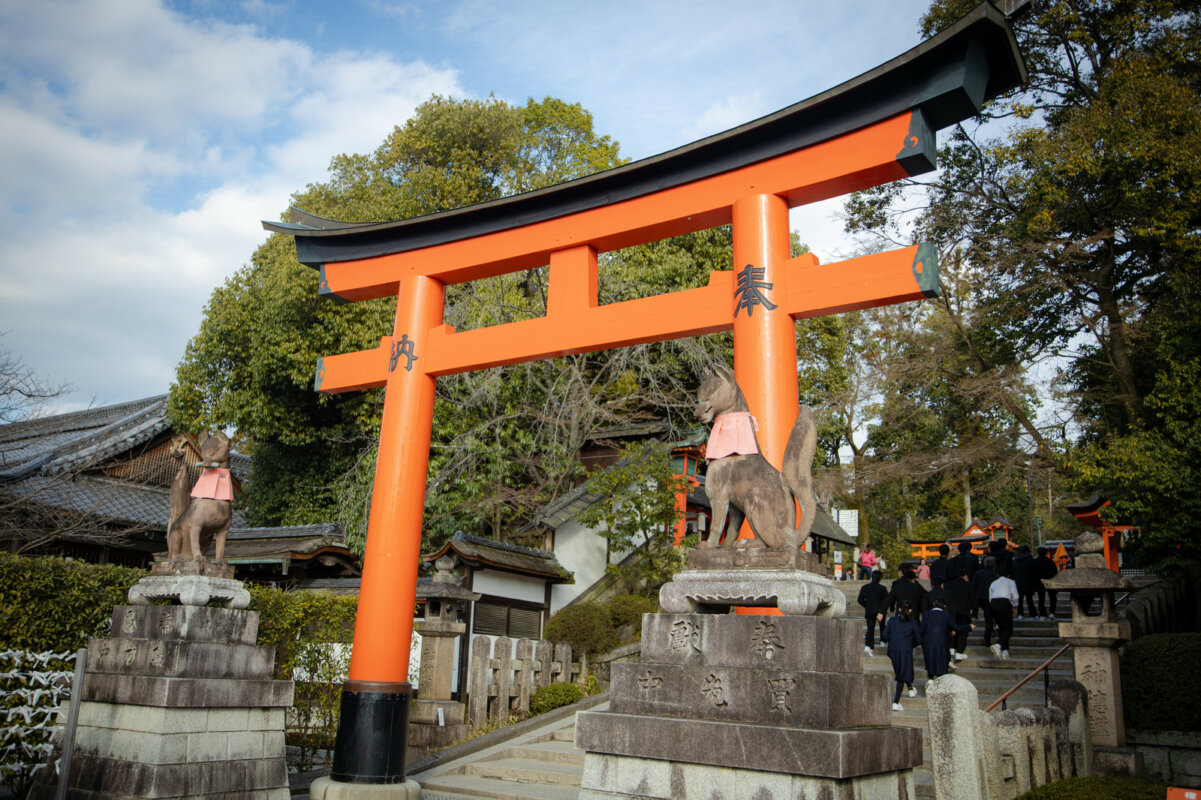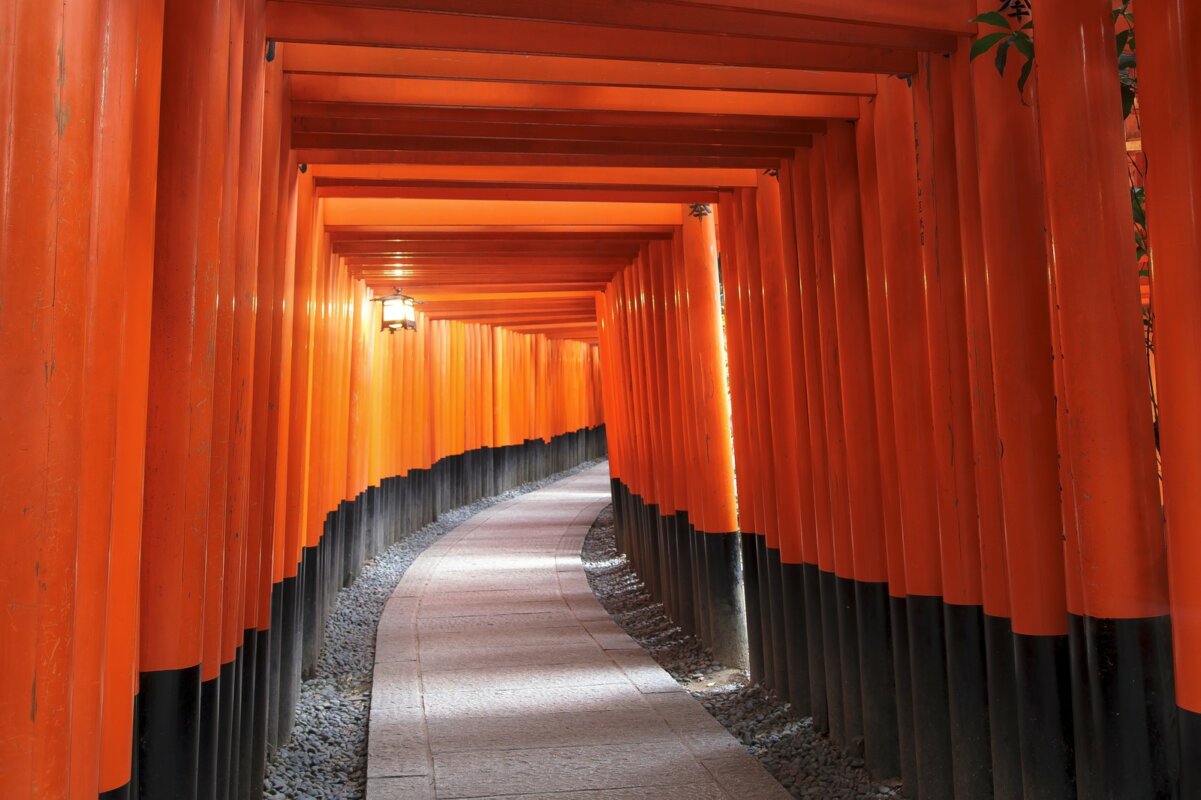Kyoto, the ancient capital of Japan, is home to over 1,600 temples and shrines, each with its own unique charm and history. In this article, we’ll explore the 10 must-visit shrines in Kyoto, where visitors can experience the spiritual and cultural wonders of this fascinating city.
Fushimi Inari Taisha

Fushimi Inari Taisha is located in southern Kyoto and is one of the most popular and iconic shrines in Japan. The shrine is famous for its thousands of bright vermillion torii gates that form a tunnel-like path up a mountain. Visitors can hike through the gates and enjoy the stunning views from the top. The shrine is dedicated to the god of agriculture and business, and visitors can pray for good luck and prosperity.
How to Access Fushimi Inari Taisha?

To access Fushimi Inari Taisha by subway, take the JR Nara line to Inari Station. From there, take the east exit and follow the signs to the shrine, which is about a five-minute walk away.
Guided Tour

For visitors who want to explore the wonders of Kyoto without the hassle of navigating public transportation, joining a guided tour is a great alternative option. One highly recommended tour includes visits to Fushimi Inari Taisha, Kiyomizu-dera, and Kinkaku-ji, as well as the beautiful Arashiyama district. With comfortable and convenient transportation to and from Osaka, visitors can relax and enjoy the tour without any stress.
Discover the tranquil beauty of Kiyomizu-dera, a UNESCO World Heritage site, and visit the gold leaf zen temple of Kinkaku-ji with its immaculate Japanese gardens. Wander through the thousands of orange torii gates winding through the wooded forests of the Fushimi Inari Shrine, and enjoy a traditional Japanese lunch meal (optional) during the tour. With a knowledgeable guide to lead the way, visitors can make the most of their time in Kyoto and create unforgettable memories.
Kiyomizu-dera

Kiyomizu-dera is a UNESCO World Heritage site and one of the most popular shrines in Kyoto. The shrine is known for its impressive wooden stage that juts out from the main hall, offering breathtaking views of Kyoto. The shrine is also famous for its pure water fountain, which visitors can drink from for good luck. Visitors can explore the surrounding gardens and enjoy the peaceful atmosphere.
How to Access Kiyomizu-dera?

To access Kiyomizu-dera by subway, take the City Bus 206 or 100 from Kyoto Station and get off at the “Kiyomizu-michi” bus stop. From there, it’s about a 10-minute walk uphill to the shrine. Alternatively, you can take a taxi or walk from nearby Gion district.
Guided Tour

For those who want to make the most of their time in Kyoto, joining a guided tour is a great option. With comfortable and convenient transportation to and from Osaka, visitors can relax and enjoy the tour without any stress. A knowledgeable guide can offer insights into the history and culture of Kiyomizu-dera, making the visit even more meaningful. Whether exploring on your own or joining a guided tour, Kiyomizu-dera is sure to leave a lasting impression.
Kinkaku-ji (The Golden Pavilion)

Kinkaku-ji, also known as the Golden Pavilion, is one of the most iconic shrines in Kyoto. The shrine is covered in gold leaf, making it one of the most photogenic spots in Kyoto. Visitors can stroll around the surrounding garden and enjoy the serene atmosphere. The shrine was originally built as a retirement villa for a shogun, and later converted into a Zen temple.
How to Access The Golden Pavilion?
To access The Golden Pavilion (Kinkaku-ji) by subway, take the City Bus 101 or 205 from Kyoto Station and get off at the “Kinkaku-ji Michi” bus stop. Alternatively, you can take a taxi or join a guided tour.
Guided Tour

Joining a guided tour to Kinkaku-ji is a great option for those who want to make the most of their time in Kyoto. With comfortable transportation to and from Osaka, visitors can relax and enjoy the tour without any hassle. A knowledgeable guide can offer insights into the history and cultural significance of Kinkaku-ji, making the visit even more memorable. Whether exploring on your own or with a guide, Kinkaku-ji is a must-see attraction in Kyoto.
Ginkaku-ji (The Silver Pavilion)
Ginkaku-ji, also known as the Silver Pavilion, is another must-visit shrine in Kyoto. The temple is known for its beautifully landscaped gardens and elegant architecture. Visitors can enjoy a stroll around the gardens and the peaceful atmosphere. The temple was built as a retirement villa for a shogun, and later converted into a Zen temple.
How to Access The Silver Pavilion?
To access The Silver Pavilion (Ginkaku-ji) by subway, take the City Bus 5 or 17 from Kyoto Station and get off at the “Ginkaku-ji Michi” bus stop. From there, it’s about a five-minute walk to the shrine. Alternatively, you can take a taxi or join a guided tour.
Guided Tour
Booking a Silver Pavilion Ginkaku-ji Temple Tour with a National Licensed Guide in Kyoto is a must for anyone interested in Japanese culture and history. This intimate tour will allow you to explore the stunning grounds of the temple and learn about its importance in Japanese culture. With no more than 15 people, you’ll get a personalized experience that is sure to leave a lasting impression.
Yasaka Shrine

Yasaka Shrine is located in the heart of the Gion district, the famous geisha district in Kyoto. The shrine is famous for its annual summer festival, one of the most famous festivals in Japan. Visitors can enjoy the traditional atmosphere of the shrine and the surrounding neighborhood. The shrine is dedicated to the god of healing and good fortune.
How to Access Yasaka Shrine?
To access Yasaka Shrine by subway, take the City Bus 206 or 100 from Kyoto Station and get off at the “Yasaka Shrine” bus stop. Alternatively, you can take a taxi or join a guided tour.
Guided Tour
For those who want to visit Yasaka Shrine and experience the best of Kyoto, the Kyoto Highlights Private Full Day Tour is a must. This personalized tour includes visits to Yasaka Shrine, Fushimi Inari Taisha, and the famous Nishiki Market, all led by a knowledgeable guide. Explore the cultural and spiritual significance of Yasaka Shrine and immerse yourself in the beauty of Kyoto. Book this tour for an unforgettable experience in Japan’s ancient capital.
Tofuku-ji
Tofuku-ji is a Zen temple that is famous for its autumn leaves, which draw crowds of visitors every year. Visitors can stroll through the gardens and enjoy the colorful foliage. The temple was built in the 13th century and is known for its impressive architecture and tranquil atmosphere.
How to Access Tofuku-ji?
To access Tofuku-ji by subway, take the Keihan Main Line to Tofuku-ji Station. From there, it’s about a 10-minute walk to the shrine. Alternatively, you can take the City Bus 202, 207 or 208 from Kyoto Station and get off at the “Tofuku-ji” bus stop, which is a five-minute walk to the shrine.
Nanzen-ji

Nanzen-ji is another must-visit Zen temple in Kyoto. The temple is known for its impressive Sanmon gate and aqueduct, which were used to bring water to Kyoto from nearby mountains. Visitors can stroll through the temple grounds and enjoy the peaceful atmosphere. The temple is famous for its cherry blossoms in the spring.
How to Access Nanzen-ji?
To access Nanzen-ji by subway, take the City Bus 5 from Kyoto Station and get off at the “Nanzen-ji Eikando-michi” bus stop, or take the City bus 100 and get off at the “Okazaki Koen” bus stop. From there, it’s a ten-minute walk to the shrine. Alternatively, you can take the Keihan Main Line to Keage Station and then walk for about 10 minutes to reach Nanzen-ji.
Heian Shrine

Heian Shrine was built to commemorate Kyoto’s 1,100th anniversary and is known for its beautiful gardens and impressive torii gate. Visitors can stroll around the gardens and enjoy the traditional architecture. The shrine is dedicated to the first and last emperors of Kyoto.
How to Access Heian Shrine?
To access Heian Shrine by subway, take the Kyoto City Subway Tozai Line to Higashiyama Station. From there, it’s about a 10-minute walk to the shrine. Alternatively, you can take the City Bus 5, 100 or 110 from Kyoto Station and get off at the “Okazaki Koen/Bijutsukan” bus stop, which is a five-minute walk to the shrine.
Shimogamo Shrine
Shimogamo Shrine is located in a forested area along the Kamo River and is known for its serene atmosphere. Visitors can stroll through the forest and enjoy the peaceful surroundings. The shrine is dedicated to the god of nature and is believed to have been established over 2,000 years ago. The shrine also hosts several festivals throughout the year, including the Aoi Matsuri, one of Kyoto’s three major festivals.
How to Access Shimogamo Shrine?
To access Shimogamo Shrine by subway, take the Kyoto City Bus 4 or 205 from Kyoto Station and get off at the “Shimogamo Shrine” bus stop. From there, it’s about a five-minute walk to the shrine. Alternatively, you can take the Eizan Line to Demachiyanagi Station and then walk for about 20 minutes to reach Shimogamo Shrine.
Kitano Tenmangu Shrine

Kitano Tenmangu Shrine is dedicated to the god of scholarship and is known for its impressive plum blossoms, which bloom in late winter and early spring. Visitors can enjoy the beautiful flowers and the traditional atmosphere of the shrine. The shrine also hosts a flea market on the 25th of each month, where visitors can browse for souvenirs and antiques.
How to Access Kitano Tenmangu Shrine?

To access Kitano Tenmangu Shrine by subway, take the City Bus 50 or 101 from Kyoto Station and get off at the “Kitano Tenmangu-mae” bus stop. From there, it’s about a five-minute walk to the shrine.
Alternatively, you can take the City Bus 55 from Nijō Station and get off at the “Kitano Tenmangu-mae” bus stop. From there, it’s about a five-minute walk to the shrine.
Bottom Line
Kyoto is a city of rich culture and history, and its temples and shrines are a reflection of that. Each shrine has its own unique charm and history, and offers visitors a glimpse into Japan’s fascinating past and spiritual traditions. With its excellent subway system, it’s easy to explore the city and visit these must-see shrines. Whether you’re interested in nature, architecture, or Japanese festivals, Kyoto’s shrines are sure to leave a lasting impression.
